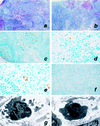Loss of CD4+ T cells in human immunodeficiency virus type 1-infected chimpanzees is associated with increased lymphocyte apoptosis
- PMID: 9573225
- PMCID: PMC109978
- DOI: 10.1128/JVI.72.6.4623-4632.1998
Loss of CD4+ T cells in human immunodeficiency virus type 1-infected chimpanzees is associated with increased lymphocyte apoptosis
Abstract
Supportive evidence that apoptosis contributes to loss of CD4+ lymphocytes in human immunodeficiency virus type 1 (HIV-1)-infected humans comes from an apparent lack of abnormal apoptosis in apathogenic lentivirus infections of nonhuman primates, including HIV-1 infection of chimpanzees. Two female chimpanzees were inoculated, one cervically and the other intravenously, with HIV-1 derived from the LAI/LAV-1b strain, which was isolated from a chimpanzee infected with the virus for 8 years. Within 6 weeks of infection, both recipient chimpanzees developed a progressive loss of CD4+ T cells which correlated with persistently high viral burdens and increased levels of CD4+ T-cell apoptosis both in vitro and in vivo. Lymph nodes from both animals also revealed evidence of immune hyperactivation. Intermediate levels of T-cell apoptosis in both peripheral blood and lymph nodes were seen in a third chimpanzee that had been infected with the LAI/LAV-1b strain for 9 years; this animal has maintained depressed CD4/CD8 T-cell ratios for the last 3 years. Similar analyses of cells from 4 uninfected animals and 10 other HIV-1-infected chimpanzees without loss of CD4+ cells revealed no difference in levels of apoptosis in these two control groups. These results demonstrate a correlation between immune hyperactivation, T-cell apoptosis, and chronic loss of CD4+ T cells in HIV-1-infected chimpanzees, providing additional evidence that apoptosis is an important factor in T-cell loss in AIDS. Furthermore, the results show that some HIV-1 strains are pathogenic for chimpanzees and that this species is not inherently resistant to HIV-1-induced disease.
Figures






References
-
- Ameisen J C. From cell activation to cell depletion. The programmed cell death hypothesis of AIDS pathogenesis. In: Andrieu J-M, Lu W, editors. Cell activation and apoptosis in HIV infection. New York, N.Y: Plenum Press; 1995. pp. 139–163. - PubMed
-
- Ameisen J C, Capron A. Cell dysfunction and depletion in AIDS: the programmed cell death hypothesis. Immunol Today. 1991;12:102–105. - PubMed
Publication types
MeSH terms
Grants and funding
LinkOut - more resources
Full Text Sources
Medical
Research Materials

